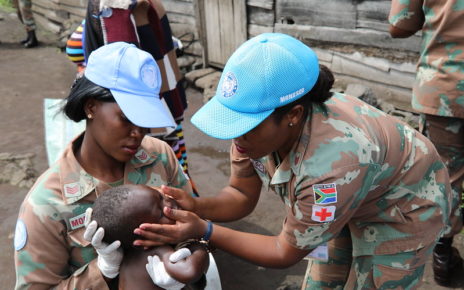Perhaps the single most famous figure in the conflict in Ukraine, aside from the heads of state, is a woman. Since her capture and imprisonment by Russia in July, 33-year old fighter pilot Nadiya Savchenko has been embraced as an undisputed hero and a national symbol of resistance. As the mythology surrounding Nadiya grows and her fate remains unknown, how are ordinary women in Ukraine experiencing the ongoing conflict?
There is excellent research emerging on women’s roles in the protest wave that led to the toppling of the Yanukovich regime and preceded the armed insurgency in the east. A study by Indiana University’s Sarah Phillips estimated that almost half of protestors were women and that while their roles tended to focus on cooking, cleaning, medical assistance and distribution of information, women also took on traditionally male roles such as mounting and “manning” the barricades. In response to resistance to their participation by some male counterparts, women self-organized, even mobilizing “Women’s Squads”, and thereby seized and created opportunities to renegotiate traditional gender roles. Other research by Onuch and Martsenyuk has suggested that these efforts were only partially successful and that gender roles and patriarchal attitudes were reinstated, especially once protests became violent.
While similar research on women in wartime Ukraine is limited, given the difficulties of conducting empirical research in the midst of ongoing hostilities, available evidence allows for an initial look at the experiences and roles of women in this conflict.
Victimization
Gender-based violence, including the systematic use of rape as well as the increase in domestic violence, has been widely recognized as a pervasive occurrence in conflict. The UN 2015 strategic response plan for Ukraine notes that “high levels of violence against women by both returned fighters and non-combatant men who find themselves idle in displacement are reported” and that there are “undocumented reports of high levels of sexual violence in the conflict area, which require substantiation and medical, psychosocial, and legal redress.”
While statistics are unavailable, NGOs, women’s rights activists and psychologists working on the ground or with displaced people from the war-affected regions in Ukraine are witnessing mounting evidence of sexualized violence in the conflict zone. For example, the Kyiv chapter of an international NGO working against human trafficking and domestic violence has detected a surge in calls to its national hotline from women in eastern Ukraine, prompting the NGO to launch an information campaign warning women of the risks. Human Rights Watch (HRW) has been researching and documenting abuse of civilians in the conflict zone, including at least one case of horrific gang rape of a woman held in captivity by pro-Russian militants.
According to HRW, both male and female pro-Ukrainian activists and journalists have been subjected to intimidation, harassment, humiliation and beatings. Women are also among the scores of individuals who have endured even more serious abuses – arbitrary detentions and torture. In one high-profile case, a 52-year old female activist was interrogated, beaten, tortured and finally forced to endure public humiliation.
A vast majority of internally displaced persons are women, many of whom become the sole caretakers of children and older relatives as they flee when their male relatives stay behind to look after property. Whether they leave or remain, women tend to suffer more hardships as a direct result of economic consequences of the conflict, are at an increased risk of human trafficking and being forced into sex work, and face acute effects of undermined health systems in areas such as maternal care.
Agency
A significant volunteer movement has mobilized to support Ukraine’s severely underfunded military, and women have been at the forefront, both as its leaders and as the rank and file. This bourgeoning civil society dominated by women has been making, collecting and distributing food, clothing, sleeping bags and military supplies in the front as well as providing humanitarian assistance to displaced people.
Women have also been active on the frontlines, providing medical and logistical support and as fighters themselves. Women are engaging in active combat with volunteer battalions on the pro-Ukrainian side as well as with rebel groups on the pro-Russian side.
… one consequence of the war has been, as is often the case in armed conflict, to reinforce gender stereotypes. Women are relegated to the sole role of supporting the men fighting on the frontlines and are excluded from the decision-making around the conflict.
Despite these notable exceptions, one consequence of the war has been, as is often the case in armed conflict, to reinforce gender stereotypes. Women are relegated to the sole role of supporting the men fighting on the frontlines and are excluded from the decision-making around the conflict. This is because women in Ukraine are acutely underrepresented in political structures and are therefore a minimal voice in conflict resolution efforts.
The OSCE’s Senior Advisor on Gender Issues has helped draw attention to the absence of women from decision making, including on peaceful resolutions to the conflict. Following a country visit in February, she stated that “enhancing the participation of women in conflict resolution and peace-building efforts is key to achieving security and stability in Ukraine”. The UN has also noted that “women are largely excluded from political and decision-making processes, and have been involved to a limited extent only in conflict-or peace-related negotiations”.
While the civil society effort represents an important area where women are exercising agency, lack of roles in the political space as well as the general hyper-militarized climate are suppressing women’s equal participation. As the conflict continues, women’s unique experiences, roles, and perspective will be a subject requiring attention from researchers, the media and NGOs.




